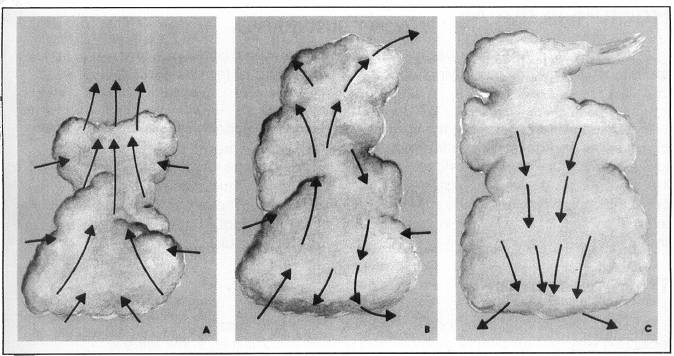Microsoft Flight Simulator Handbook
by Jonathan M. Stern
Thunderstorms
A number of conditions must combine in order to form thunderstorms. These include a sufficient amount of moisture and a force that lifts the air. This force is provided by heating from the sun, converging winds, a weather front, or other phenomena.
As the moist air is lifted, it cools, leading to condensation and the formation of cumulus clouds (the puffy cotton-ball-like clouds). The condensation of the moisture is a process that releases heat and creates further upward movement of the air. The thunderstorm has a life cycle involving three stages: the development (or cumulus) stage, the mature stage, and the dissipating stage. Figure 13.3 illustrates these stages.


During the development stage (also known as the cumulus stage), the upward-moving air builds the cumulus clouds and subsequently the cumulonimbus, or thunderstorm, cloud. The vertical development of a growing thunderstorm can exceed 3,000 feet per minute, so pilots of light aircraft should not try to outclimb a developing thunderstorm.
The developing thunderstorm contains ever larger droplets of water, which freeze when carried above the freezing level (where the air is below 32° F). At some point, the water droplets become so large that they fall as rain.
As the water droplets fall, they bring the cold upper air downward. This is the beginning of the mature stage in the thunderstorm life cycle.
The speed of the downdrafts in the mature thunderstorm may exceed 2,500 feet per minute. Meanwhile, the thunderstorm cell still contains the upward air currents, with upward moving air climbing as fast as 6,000 feet per minute. As the downward-moving air rushes out the base of the thunderstorm, it moves in different directions as it reaches the surface with its concomitant pressure attempting escape in every direction. (See Figure 13.5.)

Consequently, strong surface winds, wind shear, and turbulence are produced beneath and around the thunderstorm's base. The mature thunderstorm can reach altitudes as high as 65,000 feet, although the tops generally range from 25,000 to 45,000 feet. Figure 13.6 shows a thunderstorm at its mature stage.

Thunderstorms can produce tornadoes, turbulence, icing, hail, lightning, and low ceilings and visibilities. According to Dan Manningham, a senior United Airlines captain and frequent aviation writer,
No single cause has claimed as many lives in commercial aviation as wind shear. And no wind shear has the impact of that produced by convective storms. Thunderstorms and their associated wind shear have claimed approximately 40 percent of the lives lost in U.S. air carrier service in recent decades. . . . Your best defense is avoidance, always avoidance.
Manningham, Flee the Wrath to Come, Business & Commercial Aviation (June 1994) at 74.
When the thunderstorm moves into the dissipating stage, it no longer contains the upward moving air. The direction of airflow is all downward. When the thunderstorm runs out of energy, it leaves a series of harmless clouds in its path.
After programming a thunderstorm, you will see that these ferocious-looking creatures have tops that resemble a blacksmith's anvil. The point of the anvil cloud indicates the direction of movement of the thunderstorm. Real thunderstorms are associated with lightning, hail, wind shear, severe turbulence, heavy rain, and tornadoes. With version 5.1, Flight Simulator's thunderstorms contain airframe icing conditions and turbulence. Neither version (5.0, 5.1) contains lightning, hail, wind shear, heavy rain, or tornadoes.
Table of Contents
Previous Section: Moisture in the Air
Next Section: Turbulence
